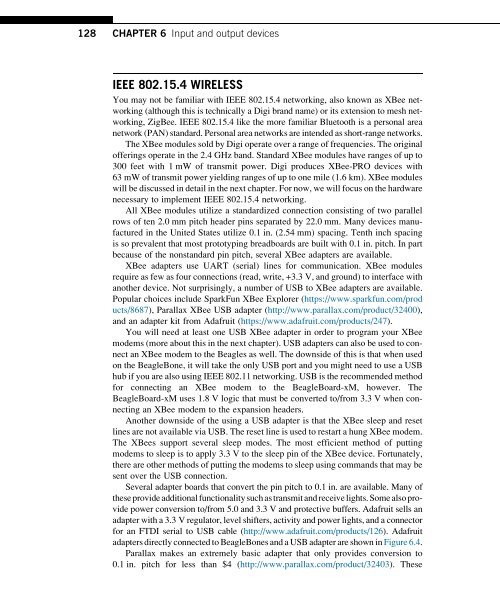Hacking_and_Penetration_Testing_with_Low_Power_Devices
Create successful ePaper yourself
Turn your PDF publications into a flip-book with our unique Google optimized e-Paper software.
128 CHAPTER 6 Input <strong>and</strong> output devices<br />
IEEE 802.15.4 WIRELESS<br />
You may not be familiar <strong>with</strong> IEEE 802.15.4 networking, also known as XBee networking<br />
(although this is technically a Digi br<strong>and</strong> name) or its extension to mesh networking,<br />
ZigBee. IEEE 802.15.4 like the more familiar Bluetooth is a personal area<br />
network (PAN) st<strong>and</strong>ard. Personal area networks are intended as short-range networks.<br />
The XBee modules sold by Digi operate over a range of frequencies. The original<br />
offerings operate in the 2.4 GHz b<strong>and</strong>. St<strong>and</strong>ard XBee modules have ranges of up to<br />
300 feet <strong>with</strong> 1 mW of transmit power. Digi produces XBee-PRO devices <strong>with</strong><br />
63 mW of transmit power yielding ranges of up to one mile (1.6 km). XBee modules<br />
will be discussed in detail in the next chapter. For now, we will focus on the hardware<br />
necessary to implement IEEE 802.15.4 networking.<br />
All XBee modules utilize a st<strong>and</strong>ardized connection consisting of two parallel<br />
rows of ten 2.0 mm pitch header pins separated by 22.0 mm. Many devices manufactured<br />
in the United States utilize 0.1 in. (2.54 mm) spacing. Tenth inch spacing<br />
is so prevalent that most prototyping breadboards are built <strong>with</strong> 0.1 in. pitch. In part<br />
because of the nonst<strong>and</strong>ard pin pitch, several XBee adapters are available.<br />
XBee adapters use UART (serial) lines for communication. XBee modules<br />
require as few as four connections (read, write, +3.3 V, <strong>and</strong> ground) to interface <strong>with</strong><br />
another device. Not surprisingly, a number of USB to XBee adapters are available.<br />
Popular choices include SparkFun XBee Explorer (https://www.sparkfun.com/prod<br />
ucts/8687), Parallax XBee USB adapter (http://www.parallax.com/product/32400),<br />
<strong>and</strong> an adapter kit from Adafruit (https://www.adafruit.com/products/247).<br />
You will need at least one USB XBee adapter in order to program your XBee<br />
modems (more about this in the next chapter). USB adapters can also be used to connect<br />
an XBee modem to the Beagles as well. The downside of this is that when used<br />
on the BeagleBone, it will take the only USB port <strong>and</strong> you might need to use a USB<br />
hub if you are also using IEEE 802.11 networking. USB is the recommended method<br />
for connecting an XBee modem to the BeagleBoard-xM, however. The<br />
BeagleBoard-xM uses 1.8 V logic that must be converted to/from 3.3 V when connecting<br />
an XBee modem to the expansion headers.<br />
Another downside of the using a USB adapter is that the XBee sleep <strong>and</strong> reset<br />
lines are not available via USB. The reset line is used to restart a hung XBee modem.<br />
The XBees support several sleep modes. The most efficient method of putting<br />
modems to sleep is to apply 3.3 V to the sleep pin of the XBee device. Fortunately,<br />
there are other methods of putting the modems to sleep using comm<strong>and</strong>s that may be<br />
sent over the USB connection.<br />
Several adapter boards that convert the pin pitch to 0.1 in. are available. Many of<br />
these provide additional functionalitysuchastransmit<strong>and</strong> receivelights. Some alsoprovide<br />
power conversion to/from 5.0 <strong>and</strong> 3.3 V <strong>and</strong> protective buffers. Adafruit sells an<br />
adapter <strong>with</strong> a 3.3 V regulator, level shifters, activity <strong>and</strong> power lights, <strong>and</strong> a connector<br />
for an FTDI serial to USB cable (http://www.adafruit.com/products/126). Adafruit<br />
adapters directly connected to BeagleBones <strong>and</strong> a USB adapter are shown in Figure 6.4.<br />
Parallax makes an extremely basic adapter that only provides conversion to<br />
0.1 in. pitch for less than $4 (http://www.parallax.com/product/32403). These


